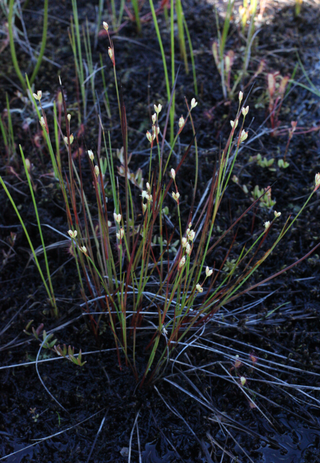
Juncaceae is a family of flowering plants, commonly known as the rush family. It consists of 8 genera and about 464 known species of slow-growing, rhizomatous, herbaceous monocotyledonous plants that may superficially resemble grasses and sedges. They often grow on infertile soils in a wide range of moisture conditions. The best-known and largest genus is Juncus. Most of the Juncus species grow exclusively in wetland habitats. A few rushes, such as Juncus bufonius are annuals, but most are perennials.

Juncus is a genus of monocotyledonous flowering plants, commonly known as rushes. It is the largest genus in the family Juncaceae, containing around 300 species.

Juncus effusus is a perennial herbaceous flowering plant species in the rush family Juncaceae, with the common names common rush or soft rush. In North America, the common name soft rush also refers to Juncus interior.

Thymus praecox is a species of thyme. A common name is mother of thyme, but "creeping thyme" and "wild thyme" may be used where Thymus serpyllum, which also shares these names, is not found. It is native to central, southern, and western Europe.

Junín National Reserve is a protected area located in the region of Junín, Peru. One of its main purposes is to protect the ecosystem and biodiversity of Lake Junín and the surrounding Central Andean wet puna.
Davidiella tassiana is a fungal plant pathogen infecting several hosts, including Iris barnumiae subsp. demawendica in Iran.

Juncus acutus, the spiny rush, sharp rush or sharp-pointed rush, is a flowering plant in the monocot family Juncaceae. It is native to the Americas, Northern and Southern Africa, Western and Southern Europe and West Asia, and is found in a variety of wet habitats, such as bogs, fens, meadows, and salt marshes, and along the edges of ponds and lakes.

Juncus balticus subsp. mexicanus, synonym Juncus mexicanus, is a species of rush known by the common name Mexican rush. It is native to much of the west of the United States, Mexico and Central and South America. It is a plant of moist areas in a great number of habitats, from coast to desert to mountain and low to high elevation.

Juncus balticus is a species of rush known by the common name Baltic rush. It is a perennial flowering plant in the family Juncaceae. It can reach a height of about 75 centimetres. It is native to north-western Europe from Spain to northern European Russia, most of North America except the south-eastern United States, parts of Mexico and Central America, and western and southern South America from Colombia to Argentina. It is available from specialist nurseries for landscaping and soil stabilization purposes.

Juncus kraussii commonly known as salt marsh rush, sea rush, jointed rush, matting rush or dune slack rush, is of the monocot family Juncaceae and genus Juncus. It grows in salt marshes, estuarine and coastal areas.

Juncus acutiflorus, also called sharp-flowered rush, is a rush or a grassy flowering plant in the family Juncaceae. As the name suggests, the plant has notable sharp-looking flowers, flowering between July and September.

Lupinus arcticus is a species of flowering plant in the legume family known by the common names Arctic lupine or subalpine lupine. It is native to northwestern North America, where it occurs from Oregon north to Alaska and east to Nunavut. It is a common wildflower in British Columbia.

Juncus inflexus, the hard rush, is a species of flowering plant in the family Juncaceae, native to Europe, Asia and Africa, and introduced in Sri Lanka, Java, Île Amsterdam and Île Saint-Paul, Victoria in Australia, New Zealand, Uruguay, and eastern North America. It is a glycophyte (non-halophyte).

Juncus alpinoarticulatus, called the northern green rush and the alpine rush, is a species of flowering plant in the genus Juncus, with a circumboreal distribution. It prefers wet sandy soils, peat bogs, acidic fens, and ditches.

Juncus stygius, called the bog rush and moor rush, is a species of flowering plant in the genus Juncus, with a high circumboreal distribution, never reaching further south than Switzerland, Korea and Upstate New York.

Juncus triglumis, called the three-flowered rush, is a species of flowering plant in the genus Juncus, native to the subarctic and subalpine Northern Hemisphere. It is typically found in calcareous tundra habitats and arcto-alpine fens. It is often found in association with Carex atrofusca and Carex bicolor in the so-called Caricion bicolori-atrofuscae alliance.

Juncus tenageia, called the sand rush, is a species of flowering plant in the genus Juncus, native to northwestern Africa, many of the Mediterranean islands, warmer parts of southern, central and eastern Europe, and western Asia including Turkey, the Caucasus region, and Kazakhstan. It is typically found growing in wet, nutrient-poor rock, sand or clay-based soils, often in clay pits, old brickyards, and on the edges of roads.

Juncus heldreichianus is a large tufted species of rush in the family Juncaceae, formed of two subspecies.

















